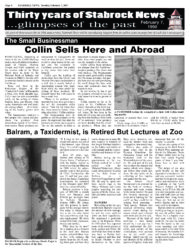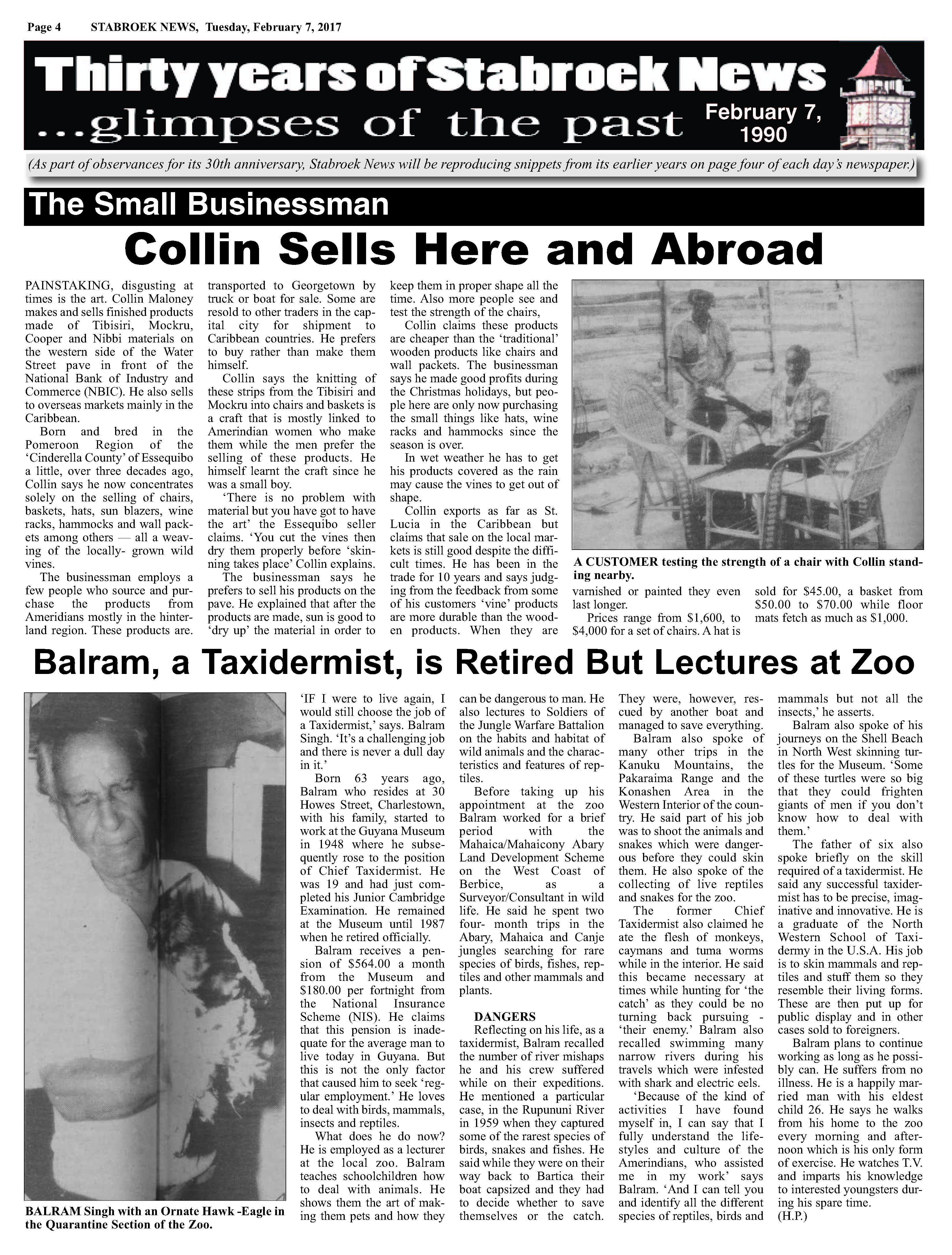PAINSTAKING, disgusting at times is the art. Collin Maloney makes and sells finished products made of Tibisiri, Mockru, Cooper and Nibbi materials on the western side of the Water Street pave in front of the National Bank of Industry and Commerce (NBIC). He also sells to overseas markets mainly in the Caribbean.
Born and bred in the Pomeroon Region of the ‘Cinderella County’ of Essequibo a little, over three decades ago, Collin says he now concentrates solely on the selling of chairs, baskets, hats, sun blazers, wine racks, hammocks and wall packets among others — all a weaving of the locally- grown wild vines.

Collin says the knitting of these strips from the Tibisiri and Mockru into chairs and baskets is a craft that is mostly linked to Amerindian women who make them while the men prefer the selling of these products. He himself learnt the craft since he was a small boy.
‘There is no problem with material but you have got to have the art’ the Essequibo seller claims. ‘You cut the vines then dry them properly before ‘skinning takes place’ Collin explains.
The businessman says he prefers to sell his products on the pave. He explained that after the products are made, sun is good to ‘dry up’ the material in order to keep them in proper shape all the time. Also more people see and test the strength of the chairs,
Collin claims these products are cheaper than the ‘traditional’ wooden products like chairs and wall packets. The businessman says he made good profits during the Christmas holidays, but people here are only now purchasing the small things like hats, wine racks and hammocks since the season is over.
In wet weather he has to get his products covered as the rain may cause the vines to get out of shape.
Collin exports as far as St. Lucia in the Caribbean but claims that sale on the local markets is still good despite the difficult times. He has been in the trade for 10 years and says judging from the feedback from some of his customers ‘vine’ products are more durable than the wooden products. When they are varnished or painted they even last longer.
Prices range from $1,600, to $4,000 for a set of chairs. A hat is sold for $45.00, a basket from $50.00 to $70.00 while floor mats fetch as much as $1,000.
Balram, a Taxidermist, is Retired But Lectures at Zoo
‘IF I were to live again, I would still choose the job of a Taxidermist,’ says. Balram Singh. ‘It’s a challenging job and there is never a dull day in it.’
Born 63 years ago, Balram who resides at 30 Howes Street, Charlestown, with his family, started to work at the Guyana Museum in 1948 where he subsequently rose to the position of Chief Taxidermist. He was 19 and had just completed his Junior Cambridge Examination. He remained at the Museum until 1987 when he retired officially.
Balram receives a pension of $564.00 a month from the Museum and $180.00 per fortnight from the National Insurance Scheme (NIS). He claims that this pension is inadequate for the average man to live today in Guyana. But this is not the only factor that caused him to seek ‘regular employment.’ He loves to deal with birds, mammals, insects and reptiles.
What does he do now? He is employed as a lecturer at the local zoo. Balram teaches schoolchildren how to deal with animals. He shows them the art of making them pets and how they can be dangerous to man. He also lectures to Soldiers of the Jungle Warfare Battalion on the habits and habitat of wild animals and the characteristics and features of reptiles.
Before taking up his appointment at the zoo Balram worked for a brief period with the Mahaica/Mahaicony Abary Land Development Scheme on the West Coast of Berbice, as a Surveyor/Consultant in wild life. He said he spent two four- month trips in the Abary, Mahaica and Canje jungles searching for rare species of birds, fishes, reptiles and other mammals and plants.
DANGERS
Reflecting on his life, as a taxidermist, Balram recalled the number of river mishaps he and his crew suffered while on their expeditions. He mentioned a particular case, in the Rupununi River in 1959 when they captured some of the rarest species of birds, snakes and fishes. He said while they were on their way back to Bartica their boat capsized and they had to decide whether to save themselves or the catch. They were, however, rescued by another boat and managed to save everything.
Balram also spoke of many other trips in the Kanuku Mountains, the Pakaraima Range and the Konashen Area in the Western Interior of the country. He said part of his job was to shoot the animals and snakes which were dangerous before they could skin them. He also spoke of the collecting of live reptiles and snakes for the zoo.
The former Chief Taxidermist also claimed he ate the flesh of monkeys, caymans and tuma worms while in the interior. He said this became necessary at times while hunting for ‘the catch’ as they could be no turning back pursuing – ‘their enemy.’ Balram also recalled swimming many narrow rivers during his travels which were infested with shark and electric eels.
‘Because of the kind of activities I have found myself in, I can say that I fully understand the life-styles and culture of the Amerindians, who assisted me in my work’ says Balram. ‘And I can tell you and identify all the different species of reptiles, birds and mammals but not all the insects,’ he asserts.
Balram also spoke of his journeys on the Shell Beach in North West skinning turtles for the Museum. ‘Some of these turtles were so big that they could frighten giants of men if you don’t know how to deal with them.’
The father of six also spoke briefly on the skill required of a taxidermist. He said any successful taxidermist has to be precise, imaginative and innovative. He is a graduate of the North Western School of Taxidermy in the U.S.A. His job is to skin mammals and reptiles and stuff them so they resemble their living forms. These are then put up for public display and in other cases sold to foreigners.
Balram plans to continue working as long as he possibly can. He suffers from no illness. He is a happily married man with his eldest child 26. He says he walks from his home to the zoo every morning and afternoon which is his only form of exercise. He watches T.V. and imparts his knowledge to interested youngsters during his spare time. (H.P.)






